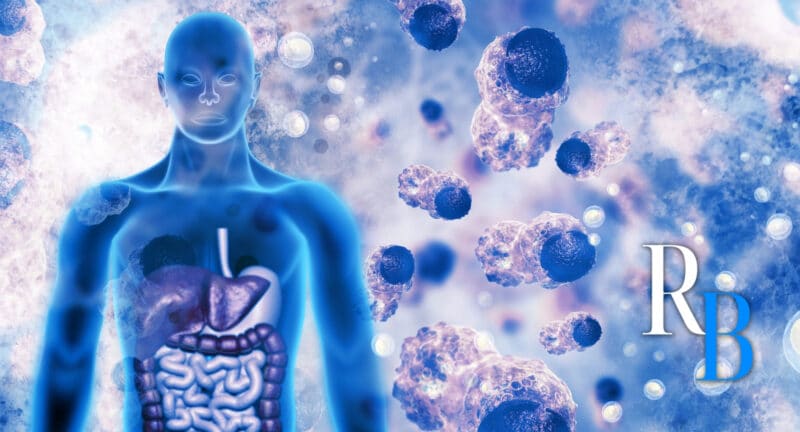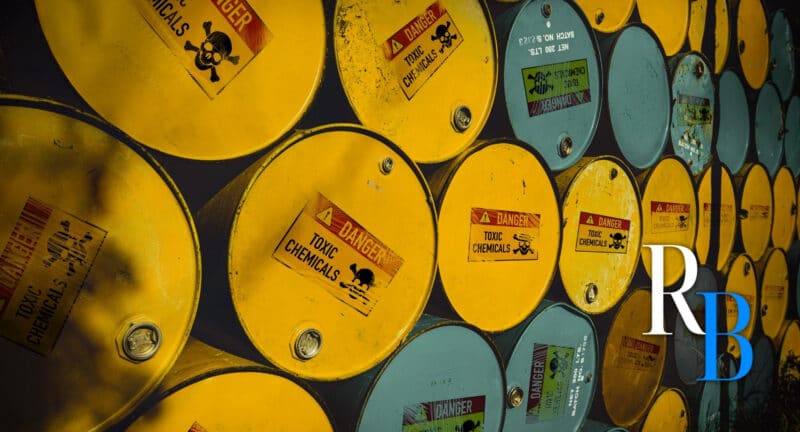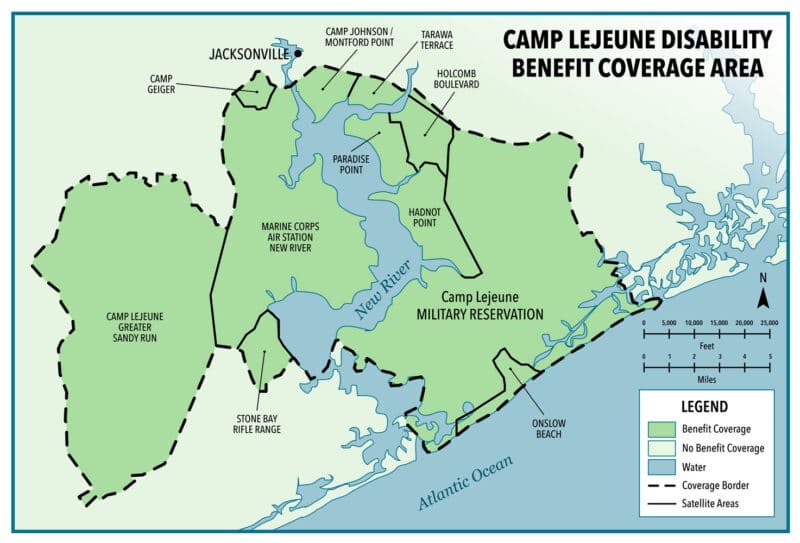CAMP LEJEUNE WATER CONTAMINATION LAWSUIT
PRACTICE AREAS

In North Carolina, Camp Lejeune Marine Corps Base is home to over 34,000 people. It is the largest Marine Corps base on the East Coast, which means it is integral for Marine expeditions. Unfortunately, this coastal encampment had a serious problem in the past: contaminated water. The Camp Lejeune water contamination from 1957 through 1987 led to links between the contamination and serious illness in residents. Those exposed to the toxic substances may be entitled to compensation for their losses. The toxic exposure lawyers at Reich & Binstock are here to represent affected veterans and their families. We offer an initial free consultation, and we don’t get a cent unless we secure a recovery for you. Call today at 713-622-7271 to schedule.
Reich & Binstock Now Taking Camp Lejeune Toxic Exposure Cases
Two of the eight water treatment plants at Camp Lejeune were contaminated from 1957 to 1987. For thirty years, the residents of the Camp lived with contaminated drinking water. For thirty years, families, children, grandparents, and veterans were drinking and bathing in toxic water. Now, researchers have linked toxic water consumption with very serious health conditions, including cancer, birth defects, and other serious illnesses.
How could the contaminated water at Camp Lejeune have been allowed to remain for three decades? Why were these harmful chemicals not discovered and addressed by officials?
As more information continues to surface about the water supply, residents and former residents have noticed some red flags. Investigations into the water contamination have led residents to believe that certain officials knew about the toxic chemicals. Further investigation is needed to determine whether or not officials knew about the toxic substances and if they attempted to cover them up.
At Reich & Binstock, our personal injury lawyers have extensive experience handling cases under the Federal Tort Claims Act. We stand ready to represent Camp Lejeune residents, Camp Lejeune veterans, and other victims. Contact our law firm today to schedule a consultation with us. We are uniquely prepared to represent veterans, their families, and anyone else who suffered due to this contamination. We have extensive experience handling VA disability claims, which could overlap with these cases in very specific ways.
Camp Lejeune Lawsuit Timeline
- 1941: Camp Lejeune officially becomes a Marine Corps base.
- 1951: The Tarawa Terrace well field is built.
- 1953: One Hour Dry Cleaner opens across the street from Tarawa Terrace. We now know that the business allowed chemicals to contaminate the water. Much of the contamination was within the Tarawa Terrace drinking water.
- 1979: From the Hadnot Point Fuel Farm, approximately 20,000-30,000 gallons of oil leaked into the ground.
- 1984: Benzene, PCE, and TCE are found at the Hadnot Point Water Well. These are all probable human carcinogens.
- 1985: All contaminated water sources that were still operational were shut down.
- 1989: The Environmental Protection Agency declares Camp Lejeune to be a Superfund site. “Superfund” is another term for the Comprehensive Environmental Response, Compensation, and Liability Act (CERCLA). It allows for the cleanup of contaminated sites. Also, it forces responsible parties to either participate in the cleanup or reimburse the cleanup costs.
- 2008: President George Bush signs a bill. The bill requires further investigation of the contaminated Camp Lejeune water.
- 2016: More than 800 water contamination lawsuits are filed through the Federal Tort Claims Act. They are all dismissed under North Carolina’s statute of repose, which is 10 years.
- 2018: All appeals are denied. Thousands of Camp Lejeune victims now have no compensation.
- 2021: In the United States House of Representatives, the Camp Lejeune Justice Act is introduced as a new bill. After being sent to committee, it stalls.
- 2022: A new Camp Lejeune Justice Act (CLJA) is introduced to the House. It is a bipartisan bill with 16 co-sponsors.
- The bill passes through the house of representatives, then goes to the Senate.
- On May 25th, 2022, the CLJA and the Honoring Our Pact Act were read in the Senate. They go on the Senate Legislative Calendar.
- The Camp Lejeune Justice Act is approved by the Senate on August 2, 2022. President Joe Biden signed the bill into law on August 10, 2022. Claimants now have two years to file a lawsuit to seek compensation.
Camp Lejeune Water Contamination Health Issues
The link between the toxic chemicals in the water at Camp Lejeune and various health conditions has been established by scientific and medical evidence. Volatile organic compounds in the water have been specifically linked to certain types of cancer, as well as other health risks.
Cancer-Causing Chemicals in Camp Lejeune Water
Residents and veterans exposed to the water contamination at Marine Corps Base Camp Lejeune are at higher risk of increased rates of specific types of cancer. Particularly, exposure to PCE and TCE is known to cause these increased cancer rates. Below, we list the cancer types linked to the chemicals involved in the water contamination.
- Liver cancer
- Breast cancer
- Lung cancer
- Kidney cancer
- Esophageal cancer
- Bladder cancer
- Leukemia
- Multiple myeloma
- Ovarian cancer
- Prostate cancer
- Cervical cancer
- Non-Hodgkin’s lymphoma
- Myelodysplastic syndrome
Non-Cancer Health Issues
Evidence continues to link the water at Camp Lejeune to health issues other than cancer. They are as follows.
- Birth defects
- Adult leukemia, aplastic anemia, and other myelodysplastic syndromes
- Fatty liver disease
- Parkinson’s disease
- Infertility
- Miscarriage
- Birth injuries
- Cardiac defects
- Brain injuries
- Scleroderma
- ALS
- Renal toxicity
- Hepatic steatosis
- Spina bifida
- Bone marrow conditions
- Neurobehavioral issues
What Chemicals Are in the Camp Lejeune Water Supply?
Hundreds of thousands of military service members and their families were stationed at Marine Corps Base Camp Lejeune during the 30-year period of contamination. During that time, active-duty personnel and their family members were ingesting contaminated drinking water. They were also bathing in heavily contaminated water. Personnel at the Tarawa Terrace and Hadnot Point treatment plants were exposed to more than 3,000 times the EPA’s maximum safe level of exposure.
Below, we outline the most prominent contaminants at the North Carolina base.
Mercury in Camp Lejeune Water
In addition to PCE and TCE, mercury also contaminated water at Camp Lejeune. In 2012, twelve pounds of mercury were found at the Hadnot Point Water Treatment Plant. It is believed that the mercury came from water pressure meters that were taken out of the plant sometime in the 1980s. Symptoms of mercury poisoning include the following.
- High blood pressure
- Vision problems, specifically a loss of peripheral vision
- Muscle weakness
- Nausea and vomiting
- Pins and needles sensation in the hands and feet, as well as around the mouth
- Metallic taste in the mouth
- Lack of movement coordination
- Speech impairment
- Hearing impairment
- Difficulty walking
Mercury exposure can affect anyone, even unborn and newborn children. Pregnant mothers can pass the element to their children. Additionally, younger children are at greater risk due to their smaller lung capacity. Camp Lejeune residents and their family members may be entitled to compensation for their losses related to mercury poisoning. Contact a Camp Lejeune lawyer with Reich & Binstock to learn more.
Chemical Waste in Camp Lejeune Water
The two main contaminants in these cases are PCE and TCE, which are volatile organic compounds. PCE is a dry cleaning solvent, while TCE is a degreaser. Obviously, neither of these compounds is safe for human consumption. Unfortunately, an additional 70+ other chemicals were found to be in the water at the North Carolina camp. Some of these chemicals include pesticides, heavy metals, and others.
Toluene
Certain workers at Camp Lejeune were exposed to Toluene, which is frequently used in paint, metal cleaners, and adhesives. Exposure happens via inhalation, getting it on the skin, swallowing it, or getting it in the eyes. Studies show that exposure increases the risks of lung cancer, esophageal cancer, liver cancer, breast cancer, kidney cancer, and bladder cancer.
Benzene
Benzene is a known human carcinogen. It is widely used as a chemical in a number of lubricants, rubbers, plastics, dyes, pesticides, drugs, and more. Generally, benzene exposure is linked to different types of leukemia, as well as non-Hodgkin’s lymphoma and multiple myeloma.
Vinyl Chloride
Vinyl chloride is a cancer-causing gas that is highly flammable. It is a man-made substance used primarily for the production of PVC products. It also occurs in tobacco smoke. Exposure to the substance is linked to higher rates of certain cancers.
Perchloroethylene (PCE)
By far, the most devastating chemical was perchloroethylene, or PCE. It has been the most significant cause of illness and death as a result of the contamination. The chemical is widely used in dry cleaning and can enter the body through inhalation, ingestion, or dermal contact. It attacks the central nervous system and various organs, and settles in the fat cells of the body. For 346 months, the Tarawa Terrace treatment center had dangerously high levels of PCE. But just how high were those levels?
The EPA explains that the maximum safe level for PCE in drinking water is 5 ug/L. The highest level of PCE contamination at Tarawa Terrace was 215 ug/L.
That’s 43 times the maximum safe level of PCE.
PCE Injuries
Strong evidence has linked PCE with a variety of ailments, including the following.
- Liver problems
- Kidney problems
- Bladder cancer
- Multiple myeloma
- Non-Hodgkin’s lymphoma
Trichloroethylene (TCE)
Trichloroethylene is used as a degreaser, as well as in the making of refrigerants, fumigants, and other compounds. Exposure happens mostly through inhalation and dermal contact. Once it gets into the bloodstream, it reaches the major organs and settles into the fat cells. Much like at Tarawa Terrace, the Hadnot Point water treatment center was badly contaminated with TCE.
The EPA explains that the maximum safe level for TCE in drinking water is 5ppb. The highest level of TCE contamination at Hadnot Point was 1,400 ppb.
That’s 280 times the maximum safe level of TCE.
TCE Birth Defects
Notably, TCE has been linked to certain birth defects at Camp Lejeune. This is partially because TCE is able to cross the placenta and affect the fetus. Studies show that there is a strong link between congenital heart defects and exposure of mothers to TCE during pregnancy.
Side Effects of Exposure to Contaminated Water
Extended exposure to TCE, PCE, and other contaminants has been strongly associated with certain cancers and serious diseases. The CDC conducted a study in 2003 that concluded that children born to contaminated mothers at Camp Lejeune were four times more likely to suffer from certain birth defects. They also have a notable higher risk of certain childhood cancers. The side effects of exposure to contaminated water are the side effects of the diseases it is linked to. These diseases are as follows for the Camp Lejeune, North Carolina water.
- Various cancers (liver, kidney, breast, bladder, ovarian, prostate, cervical, lung, and others)
- Leukemia in children and adults
- Non-Hodgkin’s lymphoma
- Liver diseases
- Birth defects
- Miscarriages
What Caused the Camp Lejeune Water Contamination?
The contamination is believed to have come from both on and off of the Marine base. Additionally, much of the contamination came specifically from an off-base dry cleaner business. This business was open before the base itself opened. Therefore, it is likely that the water wells were already contaminated when Camp Lejeune opened.
Before the realization that Camp Lejeune’s water was not safe, there were instances where wells were found to be contaminated with PCE and TCE. When this contamination was discovered, the water was labeled non-potable, or not safe for consumption. Then, the contaminated wells were either shut down or restricted. This happened as early as the 1940s.
Therefore, it is unlikely that officials were unaware of the dangers of PCE and TCE. Many Camp Lejeune lawsuits will allege that the United States federal government was aware of the contamination.
Despite their awareness, they failed to warn people of the potential dangers of the water. And despite their awareness, the government did nothing about these potentially lethal contaminants.
Camp Lejeune Justice Act 2022
At this point, everyone is in agreement that the water was contaminated. The camp was placed on the EPA’s list of Superfund sites. This basically means that the area is a complete toxic mess that requires extensive cleanup. Currently, affected Marines and their families are limited to receiving VA benefits. Many victims, their family members, and Congressmen believe that affected families deserve better. This train of thought leads us to the Camp Lejeune Justice Act 2022.
Even though many victims already receive VA disability benefits, this doesn’t always cover the same amount that a reasonable settlement would. If passed, the CLJA 2022 will provide more than just health care and disability compensation for victims. It will allow them to file a lawsuit in federal court and get around the North Carolina statute of repose which denied them in the past.
Specifically, the new law states that those exposed to the water for at least 30 days between 1957 and 1987 are eligible for compensation claims. The CLJA has already passed in the House of Representatives. It now awaits a vote in the Senate. If approved, President Biden will sign the bill into law.
As of August 10, 2022, this bill is now law. The attorneys at Reich & Binstock stand ready to represent veterans, their families, and any others who were present at Camp Lejeune during the period of contamination. Call our office at 713-622-7271 today to schedule your free consultation with us.
Are Veterans and Their Families Covered for Health Care?
The United States Department of Veterans Affairs currently offers disability benefits for those with qualifying service at Camp Lejeune. However, they must meet several key requirements first.
- The victim served at Camp Lejeune or MCAS New River for at least 30 consecutive days. This must have been between August 1953 and December 1987.
- They must not have received a dishonorable discharge from the military.
- The victim must have received a diagnosis of one of the following conditions.
- Cancer of the bladder, kidney, or liver
- Adult leukemia
- Multiple myeloma
- Parkinson’s disease
- Non-Hodgkin’s lymphoma
- Aplastic anemia
- Other myelodysplastic syndromes
- Those eligible to receive coverage are veterans, reservists, and guardsmen.
Family members can also receive health benefits from the VA. For more information about how to get benefits, please visit the Veterans Affairs website. You can also speak with one of our attorneys, and we will walk you through the process.
Is There a Camp Lejeune Class Action Lawsuit?
Not currently. There was a class-action suit filed in the past, but it was dismissed due to North Carolina’s 10-year statute of repose. The CLJA 2022 has now been signed into law. Victims and their families have already begun to file lawsuits. However, it’s important to remember that victims have only two years to file and seek compensation. Don’t wait. Call Reich & Binstock to file your Camp Lejeune claim today.
Camp Lejeune Settlement Amounts
It is still too early to predict settlement amounts. However, compensation for the contamination will be based on the extent of your illness or injuries. It will also depend on how closely we can tie your illness to the water contamination. If successful, you can likely expect compensation for health care benefits, medical expenses, and other benefits.
How Do You File a Claim for Camp Lejeune Water Contamination?
The Camp Lejeune Justice Act 2022 has now become law. Contact a qualified personal injury attorney for detailed information about how you can file your claim. Remember, victims have just two years to file their claim. Contact Reich & Binstock as soon as possible, and we will walk you through the process of filing your claim. Because we have extensive experience handling toxic tort cases, you can rest assured that you’re in good hands.
In order to have a better chance at a successful claim, we recommend gathering the following types of evidence for your case.
- Documents that prove your residence at Camp Lejeune
- Military service records with dates and locations
- Travel records
- Medical bills
- Medical records
- Veterans Administration benefits records
- Health care records
Contact our Camp Lejeune Lawyers Today
If you or someone in your family suffered injury or illness from the water contamination at Camp Lejeune, you might be entitled to compensation. At Reich & Binstock, we have extensive experience handling toxic tort cases, as well as birth injury and MDL cases. Our compassion and sense of justice for injured victims drive us to fight for full and fair compensation. To find out if you have a case, call our office today at 713-622-7271. Any confidential or sensitive information you share with us will be kept confidential. We don’t accept a dime unless we secure a recovery on your behalf.
There is never a fee unless we recover on your behalf.



















